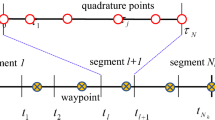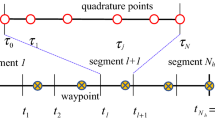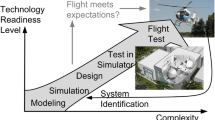Abstract
This paper treats numerical methods for an efficient prediction of the rotorcraft emergency procedures after engine failures. The analytical means of compliance for the Category-A requirements can be used for the type certification of the transport-category rotorcraft when their fidelities are approved by the civil airworthiness authority. However, the most promising trajectory optimization approaches to the Category-A maneuver analyses typically suffer from a dimensionality problem when a high-fidelity math model is adopted. To cope with such difficulties, the paper proposes new techniques, where the system states except the initial ones and all dynamic constraints are removed from the resultant nonlinear programming problem. For these proposes, the controls are parameterized using the Hermit splines with the local support and efficient recursive formulas to predict the constraint-function Jacobians are derived. The efficiency of the proposed techniques is compared with that using the pseudo-spectral collocation method. In addition to an autorotational descent maneuver, four Category-A procedures for the continued takeoff, rejected takeoff, continued landing, and balked landing maneuvers are analyzed with varying the engine-failure conditions and with a suitable consideration on the pilot-delay time to validate the usefulness of the proposed methods.











Similar content being viewed by others
Abbreviations
- Cat-A:
-
Category-A
- FAA:
-
Federal aviation administration
- AC:
-
Advisory circular
- NOCP:
-
Nonlinear optimal control problem
- NLP:
-
Nonlinear programming problem
- NAE:
-
Nonlinear algebraic equation
- SNOPT:
-
Sparse nonlinear optimizer
- OEI:
-
One-engine-inoperative
- KKT:
-
Karush–Kuhn–Tucker
- DDSA:
-
Direct dynamic-simulation approach
- SQP:
-
Sequential quadratic programming
- LGL:
-
Legendre–Gauss–Lobatto
- CTO:
-
Continued takeoff
- RTO:
-
Rejected takeoff
- CL:
-
Continued landing
- BL:
-
Balked landing
- TDP:
-
Takeoff decision point
- LDP:
-
Landing decision point
- \(J\) :
-
Objective function
- \(\phi (*)\) :
-
Boundary objective function
- \(f_{obj}\) :
-
Integral objective function
- \({\mathbf{f}}\) :
-
Forcing function in the system dynamics
- \({{\boldsymbol{\psi}}}(*)\) :
-
Equality constraints
- \({\mathbf{g}}(*)\) :
-
Inequality constraints
- \({\mathbf{x}}\) :
-
State vector of system dynamics
- \({\mathbf{u}}\) :
-
Control vector of system dynamics
- \(m\) :
-
Number of system controls
- \(n\) :
-
Number of system states
- \(L_{e}\) :
-
Number of equality constraints
- \(L_{i}\) :
-
Number of inequality constraints
- \(t\,\,(t_{0} ,\,\,\,t_{f} )\) :
-
Time variables (initial and final)
- \({\mathbf{c}}(*)\) :
-
Continuity condition
- \(J_{N,M}\) :
-
Integral part of objective function
- \(M\) :
-
Number of horizons
- \(N\) :
-
Number of collocation nodes
- \({\overline{\mathbf{y}}}\) :
-
Design variables for nonlinear programming
- \({\overline{\mathbf{v}}}\) :
-
Control vector of all horizons
- \({\mathbf{v}}\) :
-
Control and control derivatives vector of one horizon
- \(\overline{{\mathbf{h}}}\) :
-
Equality constraints for nonlinear programming
- \({\overline{\mathbf{g}}}\) :
-
Inequality constraints for nonlinear programming
- \({{\boldsymbol{\mu}}},\,\,{{\boldsymbol{\gamma}}}\) :
-
Lagrange multipliers of equality and inequality constraints
- \(L(*)\) :
-
Lagrangian function
- \(\tau\) :
-
Nondimensionalized time variable
- \(K\) :
-
Order of control derivatives
- \(\frac{\partial *}{{\partial {\mathbf{x}}_{0} }},\frac{\partial *}{{\partial {\mathbf{v}}_{k} }},\frac{\partial *}{{\partial t_{f} }}\) :
-
Jacobian matrices with respect to states, control parameters, and final time
- \(\delta\) :
-
Kronecker-delta function
- \({\mathbf{u}}^{(l)}\) :
-
\(l\)-Th time derivative of control \(( = d^{l} {\mathbf{u}}/dt^{l} )\)
- \(I_{jk}\) :
-
Integral approximation matrix
- \(\varepsilon\) :
-
Tolerance for pseudo-spectral integrator
- \(u,\,\,w\) :
-
Longitudinal and vertical velocity
- \(x,\,\,h\) :
-
Horizontal distance and height
- \(P_{*}\) :
-
Power
- \(\Omega\) :
-
Main-rotor RPM
- \(C_{T}\) :
-
Thrust coefficient
- \(C_{P}\) :
-
Power coefficient
- \(\alpha\) :
-
Main-rotor tip-path plane angle
- \(m_{h}\) :
-
Helicopter mass
- \(R\) :
-
Main-rotor radius
- \(\sigma\) :
-
Solidity of main rotor
- \(f_{e}\) :
-
Equivalent flat plate area
- \(C_{d0}\) :
-
Rotor drag coefficient
- \(a\) :
-
Lift curve slope
- \(I_{R}\) :
-
Main-rotor moment of inertia
- \(H_{R}\) :
-
Main-rotor height
- \(g\) :
-
Gravity coefficient
- \(\tau_{P}\) :
-
Time constant
- \(V_{toss}\) :
-
Takeoff safety speed
- \(\tilde{u}\) :
-
Nondimensionalized velocity
References
Robert TN, Chen YZ (1996) Optimal trajectories for the helicopter in one-engine-inoperative terminal-area operation. NASA/TM-96-110400.
Federal Aviation Administration (2018) 29-Airworthiness standards: Transportation category rotorcraft. Federal Aviation Administration 2018.
Federal Aviation Administration (2018) Advisory circular 29-2C, certification of transport categoryrotorcraft. Federal Aviation Administration 2018.
Eric BC (2001) An analytical methodology for Category A performance prediction and extrapolation. Proceedings of the American Helicopter Society 57th Annual Forum, Washington, DC, May 9–11, 2001.
Eric BC (1999) Optimal tiltrotor runway operation in one engine inoperative. Proceedings of AIAA Guidance, Navigation, and Control Conference and Exhibit, Portland, OR, August 1999.
Eric BC (1999) Optimal tiltrotor aircraft operations in power failure., Ph.D. Dissertation, Dept. of Aerospace Engineering and Mechanics, University of Minnesota, July 1999.
Zhao Y, Carlson EB, Jhemi AA, Chen RTN (2000) Optimization of rotorcraft flight in engine failure. Proceedings of American Helicopter Society 56th Annual Forum, Virginia Beach, VA, May 2000.
Bottasso CL, Croce A, Leonello D, Riviello L (2005) Optimization of critical trajectories for rotorcraft vehicles. J Am Helicopter Soc 50:165–177
Matthew WF (2009) DESCENT analysis for rotorcraft survivability with power loss. Proceedings of the American Helicopter Society 65th Annual Forum, Grapevine, Texas, May 27–29, 2009.
Padfield GD (2008) Helicopter flight dynamics: the theory and application of flying qualities and simulation modelling. Wiley, Hoboken, p 90
Subchan S (2011) A direct multiple shooting method for missile trajectory optimization with the terminal bunt manoeuvre. IPTEK J Technol Sci. 22(3). https://doi.org/10.12962/j20882033.v22i3.67.
Diehl M et al (2006) Fast direct multiple shooting algorithms for optimal robot control. Fast motions in biomechanics and robotics. Springer, Berlin, Heidelberg, pp. 65–93.
Betts JT (1998) Survey of numerical methods for trajectory optimization. J Guid Control Dyn 21(2):193–207
Gerdts M (2003) Direct shooting method for the numerical solution of higher-index DAE optimal control problems. J Optim Theory Appl 117:267–294
Rantil J, Åkesson J, Führer C, Gäfvert M (2009) Multiple-shooting optimization using the JModelica.org Platform. Proceedings 7th Modelica Conference, Como, Italy, Sep. 20–22, 2009.
Kim C-J, Sung S, Shin K (2011) Pseudo-spectral application to nonlinear optimal trajectory generation of a rotorcraft. Proceedings of The First International Conference on Engineering and Technology Innovation, Kenting, Taiwan, November 11–15, 2011.
Kim CJ, Lee DH, Hur SW et al (2016) Fast and accurate analyses of spacecraft dynamics using implicit time integration techniques. Int J Control Autom Syst 14:524–539
Williams P (2009) Hermite–Legendre–Gauss–Lobatto direct transcription in trajectory optimization. J Guid Control Dyn 32(4):1392–1395. https://doi.org/10.2514/1.42731
Baljeet S (2010) A weighted residual framework for formulation and analysis of direct transcription methods for optimal control. Ph.D. Thesis, Texas A&M University, December 2010.
Okuno Y, Kawache K (2010) Optimal takeoff of a helicopter for category A V/STOL operation. J Aircraft, March–April 1993, 30(2):235–240. Thesis, Texas A&M University, December 2010.
Lee AYN (1985) Optimal landing of a helicopter in autorotation. NASA-CR-177082, July 01, 1985.
Edward NB, Bimal LA (2003) An autorotation flight director for helicopter training. Proceedings of the American Helicopter Society 59th Annual Forum, Phoenix, Arizona, May 6–8, 2003.
Dooley LW, Yeary RD (1979) Flight test evaluation of the high inertia rotor system. Technical report, US Army Research and Technology Laboratories (AVRADCOM), Forth Worth, Texas, 1979.
Acknowledgements
This work is supported by the Korea Agency for Infrastructure Technology Advancement (KAIA) grant funded by the Ministry of Land, Infrastructure and Transport (Grant 20CHTR-C139566-04).
Author information
Authors and Affiliations
Corresponding author
Additional information
Publisher's Note
Springer Nature remains neutral with regard to jurisdictional claims in published maps and institutional affiliations.
Rights and permissions
About this article
Cite this article
Nam, Y.H., Kim, CJ., Lee, S.H. et al. Direct Dynamic-Simulation Approach to Trajectory Optimization for Rotorcraft Category-A Maneuver Procedures. Int. J. Aeronaut. Space Sci. 22, 648–662 (2021). https://doi.org/10.1007/s42405-020-00322-2
Received:
Revised:
Accepted:
Published:
Issue Date:
DOI: https://doi.org/10.1007/s42405-020-00322-2




